Overview
Brief Summary
Comprehensive Description
Distribution
Physical Description
Size
Identification Resources
Ecology
Local Distribution and Habitats
Biogeographical Distribution
Micro-habitats and Associations
Crypsis
Life History & Behaviour
Behaviour
Cyclicity
Evolution & Systematics
Fossil History
Systematics or Phylogenetics
Morphology and Physiology
External Morphology
Internal Anatomy
Cell Biology
Molecular Biology & Genetics
Nucleotide Sequences
Molecular Biology
Conservation
Trends
Threats
Wikipedia
References & More Information
Content Partners
Bibliographies
Biodiversity Heritage Library
Search the Web
Biomedical Terms
Names & Taxonomy
Related Names
Synonyms
Common Names
Page Statistics
Content Summary | Cell Biology
Asexual reproduction
It is common for polychaetes, especially benthic foragers, to lose their antennae or anterior portions of their body through the attack of predators. It is also widely accepted that in the event of sublethal predation that polychaetes are able to regenerate missing or damaged portions of their bodies (Berke et al., 2009) including antennae, parapodia and even the entire head region.
A simply-designed study which attempted to replicate the conditions of sublethal predation was undertaken with the study species of Pereinereis. Anterior segments of the body of the worm were removed and the remaining, more posterior segments were retained and photographed under a high-powered dissecting microscope each day or so. Significant parts of the process of head regeneration were captured and are described in more detail with accompanying photographs below:
|
Day
|
Regeneration Progress
|
Observations
|
|
0
|
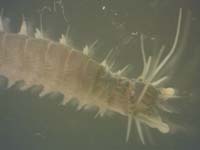 |
After head region removed hemal system was still partly functional, movement of parapodia was continuous.
|
|
2
|
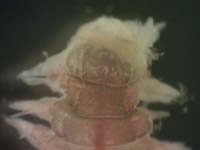 |
Longitudinal muscles have contracted to reduce the apparent size of the segments - this may function to reduce the length of the hemal system to concentrate cellular regeneration at the damaged site. Some external damage is still visible. The cuticle on the two most anterior segments appears hardened, cephalisation of two anterior possible. The hemal system is relatively stagnant at this stage which the greatest concentration of hemal fluid present in the most anterior segments; this may be the result of concentrated regeneration effort in the head region.
|
|
3
|
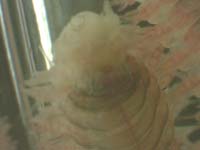 |
External damage is minimal and cuticle has overgrown the damaged site to completely enclose the organism once more. The hemal system begins pumping again.
|
|
5
|
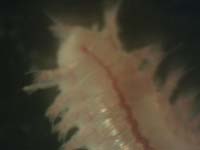 |
Most anterior segment has begun to migrate forward and a small cavity is visible in the middle of this segment; this may suggest the formation of an inpocket for the pharynx or the speecialisation of this segment to form the antennae or other 'head' appendages. There is little sensory function at this stage of regeneration.
|
|
9
|
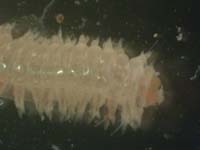 |
Two bulbous forms at organism's anterior which may form the palps, jaws or antennae; two most anterior segment begin to take the shape of the prostomium and peristomium.
|
|
10
|
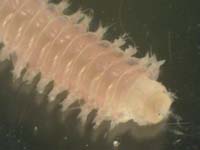 |
Two eyespots form on most anterior segment. |
Unfortunately the artificial conditions under which the rengerants were kept inhibited further observable growth. It would be interesting to examine the cellular process which enable head regeneration. Also, the anatomical changes that must occur internally in order to develop the jaws and muscular pharynx require further study.
Although regeneration has been reported in Nereididae globally no reports have been made in Australian species (Beesley et al., 2000). This study shows the capability of Australian nereids to regenerate important components of their bodies.
|
|